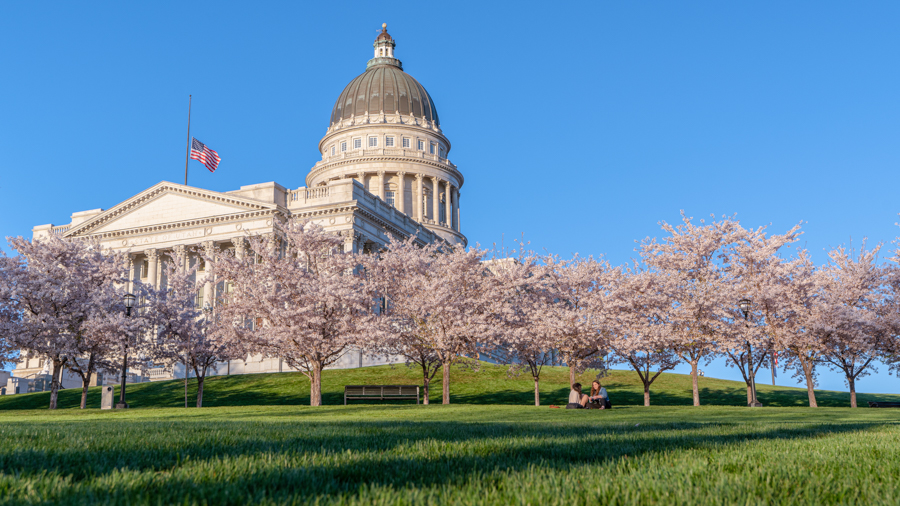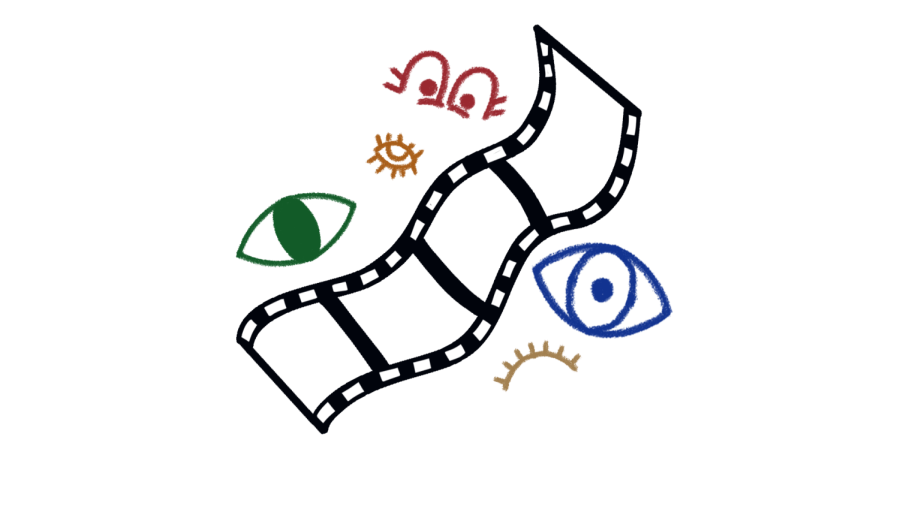Soter: Why Is Utah Lifting the Mask Mandate before Vaccinating At-Risk Groups?
Utah State Capitol on April 2, 2020. (Photo by Abu Asib | The Daily Utah Chronicle)
March 25, 2021
When I was 9 years old, I was diagnosed with asthma. My diagnosis wasn’t surprising since it runs in my family, but even so, it has been a struggle I’ve had to navigate for the majority of my life. When COVID-19 hit, that struggle intensified. Here was this uncharted virus killing people left and right, especially people like me: people with underlying respiratory conditions. COVID-19 turned my life, like so many others’, completely upside down. I’ve lived in agonizing anxiety that has only sharpened since the lockdown ended.
When the school year started and I had to go back to work for financial reasons, my fear escalated dramatically. My only hope was that the vaccine would soon arrive and save me from my justified agoraphobia, and yet that wasn’t the case. When the Utah vaccine requirements were released, asthma was not on the list. In fact, it was explicitly excluded from the list. The requirement for respiratory diseases states: “Severe chronic respiratory disease (other than asthma) including severe chronic obstructive pulmonary disease, fibrosing lung disease, bronchiectasis, or cystic fibrosis.” I was shocked by this. The only morally acceptable choice was to wait in my chronic anxiety until the list broadened. But only now, nearly three months since the vaccine rollout began, do I qualify to access it, along with every other Utahn 16 and older. After thorough research of the system in place for Utah’s vaccine distribution, I’m not convinced that my decision to wait was the right one. If I’m convinced of anything it’s that Utah’s distribution of the COVID-19 vaccine has been less than adequate and must be reconsidered for the well-being of the state.
Utah has received 1,321,750 doses and have only administered 1,137,511 as of March 23. States like Wisconsin, on the other hand, have used 92.82% of their vaccine doses. But then again, places like Wisconsin care about their residents enough to open requirements to people in almost all essential professions, including people in the food industry and those that operate public transportation. Unfortunately, we can’t say the same about Utah.
Utah also ranks 50th in the country concerning the percentage of the population that has been fully vaccinated, which is 9.6% as of this writing. Comparatively, there are 14 states nationwide that have already vaccinated more than 28% of their constituents.
These saddening numbers surely have a lot to do with the vaccine hesitancy that we have seen across the country, especially in places like Utah, because of the conservative majority’s illogical yielding to bizarre conspiracy theories. Perhaps this is the reason that informative fact #6 of the seven on Utah’s coronavirus webpage is that “COVID-19 vaccines don’t contain microchips or tracking devices.”
Or maybe it is why David Glenn, a pharmacist at HRx Pharmacy in Holladay, Utah, has had such a hard time booking vaccine appointments. When I talked to Glenn the first week his pharmacy began scheduling appointments, he said, “We’re only getting a hundred of the Johnson & Johnson on a weekly basis. And the Pfizer is coming in about 1100 something. I forget the exact number, but it’s just over a thousand. This week, we didn’t have that many appointments scheduled. It’s the first week and so we weren’t sure we could use all those [vaccines].” He went on to explain that the state had to pick up around 500 vaccines from him at the beginning of the week to take to other distribution centers, but it is unknown if they were able to be used when they arrived.
Whatever the ripple effect of vaccine aversion, our elected officials realize that it is problematic and will continue to be in the future. Gov. Spencer Cox recently said in a Salt Lake Tribune article that “starting into April and May, our biggest concern is going to be vaccine hesitancy, like, how do we convince people to get this vaccine because we have so much of it.” Vaccine hesitancy in Utah will continue to increase the percentage of wasted vaccines the state has seen thus far.
My greatest concern, though — the reason I felt I had to write this article — is the fact that Utah is lifting the statewide mask mandate on April 10. This means people like me who are high risk for COVID-19 but not high risk enough to have been prioritized for vaccines will not only be vulnerable to the virus due to lack of vaccination but will also not have the protection of masks. Even so, we will still be forced to go to work, school, grocery stores and elsewhere to ensure our livelihood.
After his initial announcement that all Utah adults would be eligible to receive the vaccine on April 1, Cox moved that date up to March 24. While this change technically allows all residents 16 and older access to the vaccine, it also ensures that the system will be overwhelmed — meaning not all Utahns will be able to guarantee their appointments in time for the mask mandate removal. Furthermore, unless the state distributes the Johnson & Johnson vaccine exclusively from March 24 forward, it is chronologically impossible that currently ineligible adults will be fully vaccinated by the time the mask mandate is lifted. These irresponsible choices of the Utah State Government are beyond unjust and the fact that our elected officials are touting them as the opposite is beyond ignorant; it’s inhumane.
Before writing this article, I asked 25 college students if they’d lie to get the vaccine if they knew doses were being thrown away. 14 of them said yes. People, especially those at risk of serious illness from COVID-19, want the vaccine; and they are the ones who should get it. Instead of labelling them “line-jumpers” or “unethical,” we should recognize that Utah’s distribution system is flawed, and demand that the state offer real protections to critical populations before lifting the mask mandate.









Susan M • Mar 28, 2021 at 1:53 pm
@Neil Smith No law would ever be needed if people just did the right thing in the first place. The mask mandate was instituted because overwhelmed health care professionals begged the Governor to do something—ANYTHING to help them, and free people were NOT choosing to do the right thing on their own. On the contrary, Trump was lying about the virus’ severity, sending mixed messages on mask-wearing, and the right was actively spreading misinformation about the virus’ very existence.
Wearing a mask protects others, not yourself. So if you want protection, then apparently you have to rely on others to do the right thing, which few in Utah choose to do. In fact, there is outright resistance to mask wearing due to conservatives’ politicization of masks as a public health initiative. For “Christians” who have been instructed to “love thy neighbor as thyself”, that is disturbing and immoral behavior.
Neil Smith • Mar 26, 2021 at 9:46 pm
This might blow your mind, but you can still wear a mask after the mandate is lifted. It is possible to do something without the government forcing you to do it.
John Hedberg • Mar 26, 2021 at 7:42 pm
“Utah has received 1,321,750 doses and have only administered 1,137,511 as of March 23. States like Wisconsin, on the other hand, have used 92.82% of their vaccine doses. But then again, places like Wisconsin care about their residents enough to open requirements to people in almost all essential professions, including people in the food industry and those that operate public transportation. Unfortunately, we can’t say the same about Utah.”
That’s kind of a negatively emotional statement outside the evidence, isn’t it? States get vaccine shipments once a week, so depending on which day of the week you check, the percentage of those used will vary widely. Anyone who looks at the state website can see this ratio rapidly changing day to day, so your false assertion about Utah’s supposedly lower use of available vaccine supplies is based on lack of research.
Utah’s population in 2021 is estimated at 3.34 million. As of March 26th, 24.99% (834,899) have received at least one dose, and 13.77% (460,047) have been fully vaccinated, including 2/3 of Seniors 70+, the most vulnerable age groups.
https://coronavirus.utah.gov/case-counts/
Utah (unlike many racist “equity” states) decided to vaccinate the demographic groups most vulnerable to hospitalization and death first, so Utah’s Case Mortality Rate is %0.54, the second lowest mortality rate in the county, after Alaska. In other words, Utah followed the science, so more of the most vulnerable people per capita were saved from death than anywhere else that has a 12-month functioning road system.
A lot of us have breathing issues. Just because a lockdown ends doesn’t mean you’re at greater risk. Salt Lake County had an active mask mandate long before the state did, and they’ll have one until Mayor Wilson feels the county is safe again without one, which shouldn’t be long, considering all of those most vulnerable to hospitalization and death should be fully vaccinated by Mother’s Day. Have you considered shopping over-night? I do. If you don’t want to go out, don’t, but why deny other people the right to go out who can find ways to do so in relative safety? Isn’t that putting your own feelings ahead of their actual scientific well-being? Why risk being narcissistic? Let people make their own best informed choices, everyone.
California is still in lockdown, yet their per capita infection and mortality rates are far higher than Utah’s (check their website), even after accounting for population size difference. For months, the science has shown that the most likely place to catch the virus is actually in the household, which is why many found the teachers unions’ reluctance to return to in-person classes so ironic, since statistics show they were actually less likely to catch the virus in school than at home.
https://www.washingtonexaminer.com/news/study-low-coronavirus-transmission-schools?fbclid=IwAR2uep5U2g5izBMpJcVYvlrp3tQzc7Z1dYgq-pfMqJ_g3aaK4i1_Mj485kU
Utah did offer the vaccine to many “essential workers”, mostly in health care and education, back in January, which you would have known if you’d followed the Salt Lake County website.
https://slco.org/health/COVID-19/vaccine/
Compared to most other states, Utah has actually seen a quicker vaccination of it’s groups most vulnerable to hospitalization and death. Utah was weeks ahead of California in vaccinating those 16+ with underlying health conditions, and both used the same CDC-based list of health conditions. Since I have a breathing issue, I checked. So your claim that Utah doesn’t care is simply another erroneous and actively pejorative assumption that says more about your own lack of willingness to research beyond your own biases than about the people you falsely accused (hate speech) of willful malfeasance, something even a non-journalist should know better than to engage in. If that statement sounds painfully direct, compare it to the false and hostile accusations you made about “conservatives”, which were as categorically and stereotypically biased as they were untrue. Dehumanizing whole groups you enjoy categorizing & stereotyping, as you just did, is where bigotry and hate speech comes from, something a communications major should be aware of, within and without, at all times.
With Love,
John
Feel free to respond, and stay healthy!!
Abby • Mar 26, 2021 at 3:57 pm
First, Utah isn’t that far behind. Utah’s at 86.1% compared to Wisconsin’s “impressive” 92.8%. That’s 6.7%. That doesn’t show very much, especially considering that people in Utah are much more spread out. You’ve seen those light pollution maps, right? There are way more people in Wisconsin—even rural parts! Utah isn’t as vaccinated partially because you don’t need to vaccinate someone who lives 3 miles away from the next farmer.
Next, I agree, you probably should’ve had the vaccine earlier than the general population, but I understand why they excluded asthma. Asthma can be severe, but it can also be mild. Someone with exercise-induced asthma shouldn’t be able to get the vaccine before the mother of a child at Huntsman.
Third, I don’t appreciate your insistence that conservatives are associated with conspiracy theorists. Yeah, there are conspiracy theorists who are conservative, but there are conspiracy theorists who are progressive, too. It’s really easy to blame others, but it’s taken a group effort to get us here. I think lately, the country’s been all about denying any wrongdoing and blaming others—especially in politics.
Fourth, I’m speaking from a place of understanding: I know what the risks are, especially when you have underlying health conditions. But covid, even when combined with a history of life-threatening diseases and a weakened immune system, isn’t as big of a threat to me as is the depression and suicidality that came after the third month of solitary confinement in the lockdown. But it’s okay, I know it’s human nature to assume our individual problems are worse than everyone else’s.
I’d just like everyone to stop acting like our problems are worse than everyone else’s problems (our illness, our violent crimes, our conspiracy theorists, our covid spread, etc.), and own up to their own culpability in whatever bad situation we’re in. I’ll go first! I didn’t keep in touch with a couple friends, and that added to my depression. There’s a lot at play, but there aren’t very many simple solutions.
O'Connor • Mar 26, 2021 at 2:50 pm
I agree with your general consensus – we definitely shouldn’t be lifting a mask mandate, not after we’ve come so far making progress. It would be a shame to see all the hard work people have done over the past year erased because we’ve jumped the gun.
Other than that, however, I have a couple of issues with the states you’ve presented.
Yes, Utah does rank last in terms of percentage of population fully vaccinated. However, we don’t rank last in percentage population receiving at least one dose (46 out of 50, which admittedly still isn’t good)
But, I think the key issue I have is that Utah is actually doing quite well in terms of doling out what we have, and seeing it used. We rank 13/50, using 1,214,131 out of 1,491,140 doses delivered, or 81% of total doses. I don’t know why the pharmacist you interviewed has doubts about vaccinations, but the pharmacy my wife gives vaccinations at is inundated every day with patients trying to get vaccinated, despite doubling the allowed vaccinations-per-day allowed half a month ago.
To compare us with Wisconsin, the state ranking 1/50 in terms of vaccination usage is misleading and trivializes all the hard work healthcare providers in Utah have done to save lives.